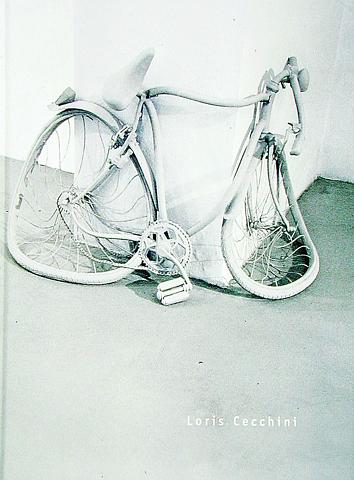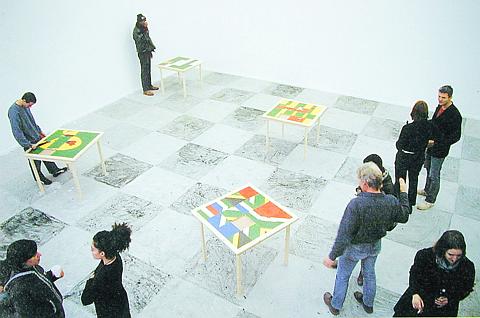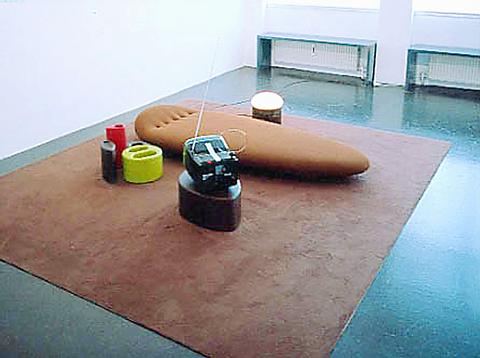With 31 artists from 20 countries set to participate in the upcoming Taipei Biennial, the city art scene is set to show its sophistication and diversity. And to let the global art community know that it's come a long way since hosting a more limited biennial in 1998.
Organized by the Taipei Fine Arts Museum, the festival will jump outside the limited East Asian scope of its predecessor, dubbed "Site of Desire." The effort of the Taipei museum to broaden and reach out has always been a goal of its management, which has continually pursued making the museum an international contender.
Acclaimed curator Jerome Sans from Paris and Taipei based Manray Hsu (徐文瑞) started to work on the project in February and have spent NT$24 million. Sans is the co-director of the Palais de Tokyo in Paris and adjunct curator at the Institute of Visual Arts in Milwaukee, Wisconsin. His coming on board was a much-anticipated blessing by local arts circles, especially since he contributed to the 1999 Venice Biennale. Hsu, on the other hand, is a local curator and art critic, a rising star who has nurtured the developing contemporary art scene in Taiwan.

PHOTO: TAIPEI FINE ARTS MUSEUM
The curators, a group of advisors from local arts circles, and the professional staff of the museum have worked together to select the 31 artists from around the globe. In general, they looked for artists that are futuristic and international in scope. Those who dare venture into technology, for example, are valued for their experimentation with the digital world.
The two curators finalized the theme of "The sky is the limit" in June. It's a wide open world under the sky and the implication is that there are all kinds of possibilities, infinite and boundless. The theme is tied into the timing of crossing into the new millennium. Curator Sans stressed the word hybrid in shaping a new world. The show will be small scale and intimate, yet it will also follow a theme of globalization.
The curators said that they want this occasion to be a forum to showcase the collective experiences of the participating artists and audiences. The sense of novelty is strong and the curators promised to "create a lab where actions and fantasies can be put into experimentation."

As the biennial attracts locals and foreign visitors alike, there is certain to be discussion about how such an event can serve to develop the Taiwan arts. Already people have questioned the residual impact of such a large-scale, costly venture in an attempt to determine its contribution to the growth of contemporary art in Taiwan, which is still not adequately developed, said Rita Chang (張元茜), independent curator and Taipei representative of Asia Culture Council.
Chang also pointed out that what's essential is that peripheral facilities have to be built to establish a sound environment for contemporary art, with the biennial serving as a catalyst.
Another benefit of the biennial is the increased media attention, as hundreds of arts writers and critics descend upon Taipei to cover the event. And what they will see is a more vibrant scene than a few years back. Venues such as the Washang Cultural District, an alternative space, have started putting together better exhibitions as support for contemporary art increases and can serve as side-stops for visitors to the biennial.

The Taipei Contemporary Art Museum is also scheduled to open early next year, which means debates and activities will abound this year to prepare for it. And the Taipei Fine Arts Museum itself will schedule two fascinating shows alongside the biennial. "Zero-in," curated by Chang, celebrates the new millennium and probes into the e-era, and "Taipei Chinese Chess" is a solo exhibition of Ren Rong, a Chinese artist using paper art and installation to make humanlike creatures that examine the relationship between nature and man.Participating artists
Candice Breitz (South Africa)
Hsia-fei Chang (Taiwan)

Shu-lea Cheang (Taiwan)
Loris Cecchini (Italy)
Claude Closky (France)
Meschac Gaba (Benin)
Kendell Geers (South Africa)
Gim Hongsok (South Korea)
Hanayo (Japan)
Hung Dung-lu (Taiwan)
Kim Soo-ja (South Korea)
Surasi Kusolwong (Thailand)
Kyupi Kyupi (Japan)
Lee Ming-wei (Taiwan)
Mark Lewis (Canada)
Michael Lin (Taiwan)
Liza Lou (USA)
Michel Majerus (Germany)
Jonathan Monk (United Kingdom)
Daniel Pflumm (Germany)
Henrik Plenge Jakobsen (Denmark)
Navin Rawanchaikul (Thailand)
Tobias Rehberger (Germany)
Sidney Stucki (Switzerland)
Pascale Marthine Tayou (Cameroon)
Uri Tzaig (Israel)
Wang Du (China)
Wang Jun-jieh (Taiwan)
Wang You-shen (China)
Erwin Wurm (Austria)
Jun'ya Yamaide (Japan)

A vaccine to fight dementia? It turns out there may already be one — shots that prevent painful shingles also appear to protect aging brains. A new study found shingles vaccination cut older adults’ risk of developing dementia over the next seven years by 20 percent. The research, published Wednesday in the journal Nature, is part of growing understanding about how many factors influence brain health as we age — and what we can do about it. “It’s a very robust finding,” said lead researcher Pascal Geldsetzer of Stanford University. And “women seem to benefit more,” important as they’re at higher risk of

March 31 to April 6 On May 13, 1950, National Taiwan University Hospital otolaryngologist Su You-peng (蘇友鵬) was summoned to the director’s office. He thought someone had complained about him practicing the violin at night, but when he entered the room, he knew something was terribly wrong. He saw several burly men who appeared to be government secret agents, and three other resident doctors: internist Hsu Chiang (許強), dermatologist Hu Pao-chen (胡寶珍) and ophthalmologist Hu Hsin-lin (胡鑫麟). They were handcuffed, herded onto two jeeps and taken to the Secrecy Bureau (保密局) for questioning. Su was still in his doctor’s robes at

Last week the Democratic Progressive Party (DPP) said that the budget cuts voted for by the China-aligned parties in the legislature, are intended to force the DPP to hike electricity rates. The public would then blame it for the rate hike. It’s fairly clear that the first part of that is correct. Slashing the budget of state-run Taiwan Power Co (Taipower, 台電) is a move intended to cause discontent with the DPP when electricity rates go up. Taipower’s debt, NT$422.9 billion (US$12.78 billion), is one of the numerous permanent crises created by the nation’s construction-industrial state and the developmentalist mentality it

Experts say that the devastating earthquake in Myanmar on Friday was likely the strongest to hit the country in decades, with disaster modeling suggesting thousands could be dead. Automatic assessments from the US Geological Survey (USGS) said the shallow 7.7-magnitude quake northwest of the central Myanmar city of Sagaing triggered a red alert for shaking-related fatalities and economic losses. “High casualties and extensive damage are probable and the disaster is likely widespread,” it said, locating the epicentre near the central Myanmar city of Mandalay, home to more than a million people. Myanmar’s ruling junta said on Saturday morning that the number killed had